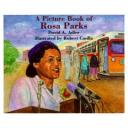A Picture Book of Rosa Parks
- Author: David Adler Illustrator: Robert Casilla
- Publisher and date: Scholastic, 2001
- Genres: biography
- Age/Grade: 1-5
Author’s perspective: David Adler has an outside perspective. It is one book from his series of picture book biographies.
Literary Elements:
Vocabulary –There are several words that are used during discussion of the civil rights movement that are in this book: boycott, oppression, segregation, discrimination. The description of “boycott” in this book makes it easier for students to understand.
Style: The author provides a lot of facts that are probably more appropriate for older students than the ones I work with. I think many of the facts go over my students’ heads.
Tone: There is not a lot of emotion in the writing. It has more of a “this is the facts” feel to it. The illustration of the Ku Klux Klan is a little scary for some younger students.
Summary:
This is the story of Rosa Parks. We learn about her younger years with her family. After she marries her husband, she becomes involved with the NAACP to help work towards equal rights for all. We read about both incidences on the buses which puts Rosa into the public eye and eventually earns her the title of “Mother of the Civil Rights Movement.”
Curriculum Connections:
I like to include this book in my Martin Luther King unit. Rosa Parks is mentioned in most of the Martin Luther King books that I use, so I like to read a book all about her. This also shows how women, along with men, help to change the world.
Some questions during read aloud:
- How did the boycott help to change the laws?
- How is Rosa Parks similar to Martin Luther King?
After reading about Rosa, by Nikki Giovanni in one of the articles for class, I want to check it out and add it to my unit.
Web Resources:
Review:
From Booklist
Gr. 2-4. In this volume of his fine Picture Book Biography series for younger readers, Adler sets the life story of Rosa Parks within the history of the civil-rights movement. The simple narrative text and the dramatic color illustrations show the discrimination that was common when Parks was growing up: one double-page spread depicts the insult of separate water fountains; another shows the Ku Klux Klan terror with flaming torches. Then there’s the crucial confrontation in 1955 when Parks is arrested for refusing to give up her seat on the bus to a white passenger. How her brave act started the Montgomery bus boycott led by Dr. Martin Luther King, Jr., is stirring history. In addition to the sweeping political scenes, there are portraits by Casilla that capture the ordinary person who made a difference. Hazel Rochman –This text refers to the Hardcover edition.
From School Library Journal
Gr 2-4-Adler presents a biographical account of the longtime and committed civil-rights activist, whose role in initiating the Montgomery bus boycott was but one aspect. He also brings in other issues, such as school desegregation and the presence of the Ku Klux Klan. While these inclusions diffuse his focus, they also give young readers background on the time and the movement in which she participated. Brief notes offer additional information about Tuskeegee Institute, located near Parks’s birthplace, and Thurgood Marshall, who successfully argued the Brown v. Board of Education desegregation case before the Supreme Court. Casilla’s illustrations are realistic and useful, though somewhat static and lacking in excitement. The text also tends toward dryness. Still, Adler’s sensitive writing and broad perspective on his subject’s life make this a useful source for young children.-Lyn Miller-Lachmann, Siena College Library, Loudonville, NY
